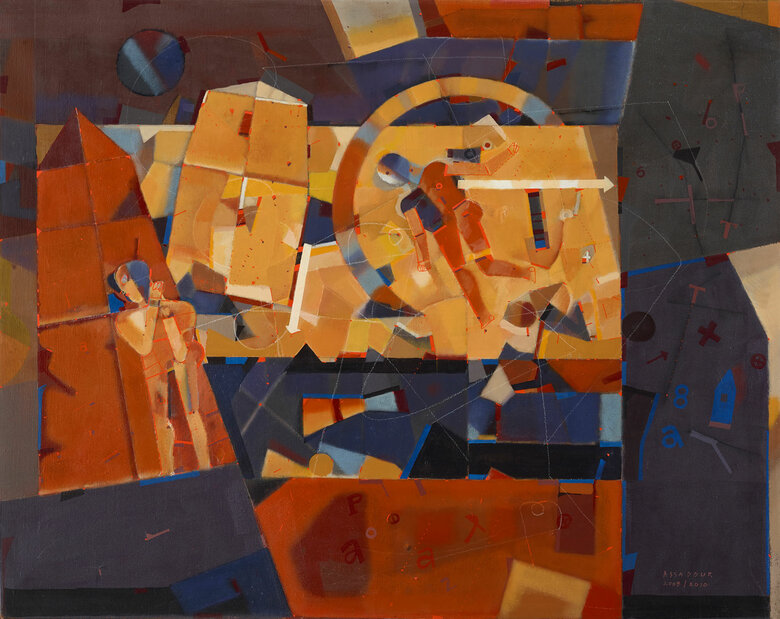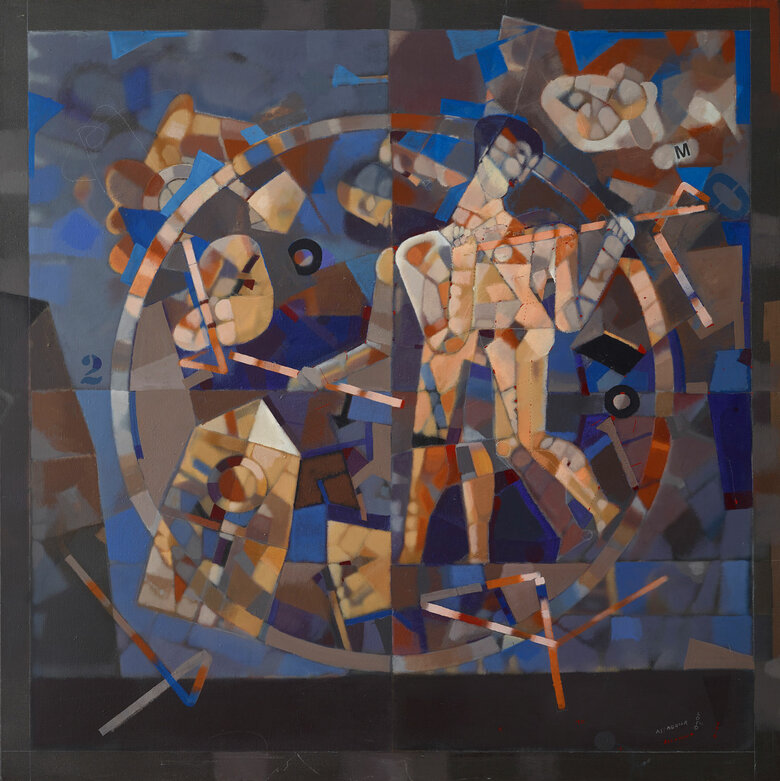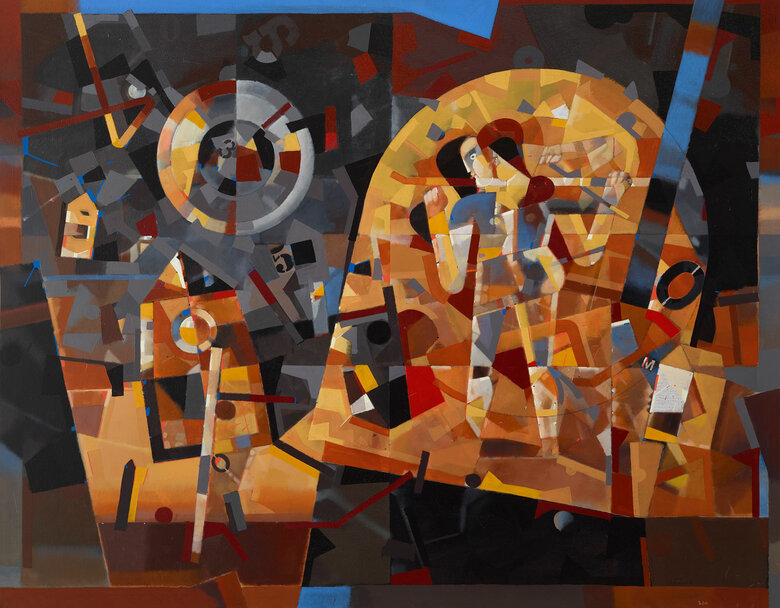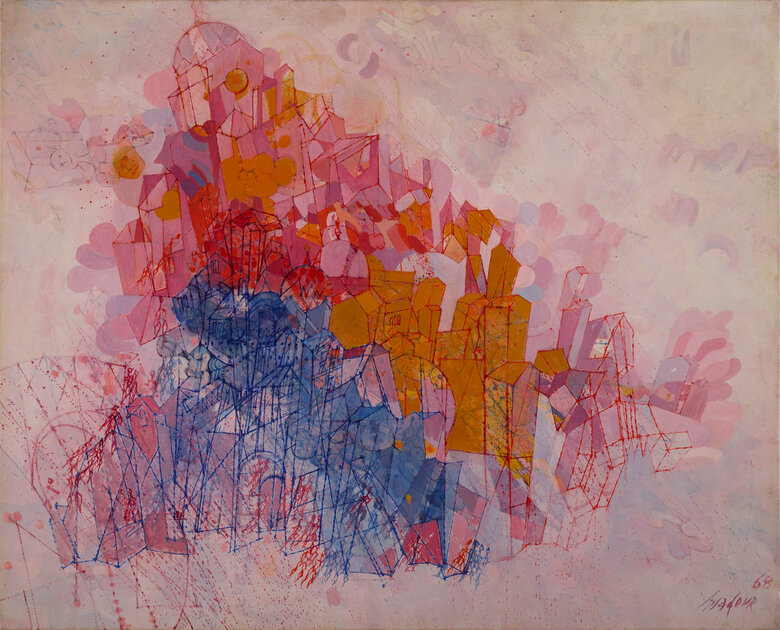Assadour Bezdikian, commonly known by Assadour, was born in Bourj Hammoud, a popular neighborhood in the northern suburbs of Beirut, Lebanon, in 1943, to a family of Armenian origin. Early in his...
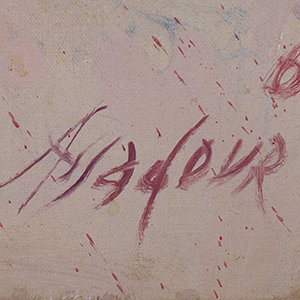

ASSADOUR BEZDIKIAN, Lebanon (1943)
Bio
Written by FADIA ANTAR
Assadour Bezdikian, commonly known by Assadour, was born in Bourj Hammoud, a popular neighborhood in the northern suburbs of Beirut, Lebanon, in 1943, to a family of Armenian origin. Early in his youth, Assadour showed a rebellious character and challenged the old traditional school system that did not adapt to his free spirit. His immediate interest in art, directed the young Assadour to take a few painting lessons with the artist Paul Guiragossian (1926 -1993) and to join the art studio of the Lebanese painter, Guvder (1923-2016). Later, he enrolled at the Italian Cultural Center in Beirut, where he was taught art under the Lebanese painter, Jean Khalife (1925-1978)[1]. The Italian Cultural Center granted him, for two consecutive years, a three months scholarship to study at the Pietro Vannucci Academy, in Perugia, in Italy, in the summers of 1962 and 1963[2]. At the Pietro Vannucci, Assadour was mentored under the Franciscan priest Diego to execute his first engraving. He got acquainted with the Italian Renaissance and discovered through several trips around Italy, the art of Giotto, Uccello, and many others[3]. Assadour developed, through his Italian experience, an attachment to the drawing, while the painting was more valued at the Beirut's art scene at that time. He realized that the horizon for a painting career in Beirut didn’t fit his challenging vision that questioned the existing local art practices, in the 60s[4]. In 1964, he won a competition organized by the Lebanese Ministry of Culture, which granted him a three-year scholarship to study at the Ecole Nationale Superieure des Beaux-Arts in Paris. There, he trained at the workshop of Lucien Coutaud (1904-1977).[5]
In his training at Lucien Coutaud’s workshop as at the Pietro Vannucci, Assadour received a dense formal and technical education; he enhanced his natural talents with control, precision, and application in watercolor, drawing, and painting, but mostly in engraving. Paris was Assadour’s encounter with constructivism, abstraction, and expressionism, and it could be argued that each of these styles left their mark on the pupil at the time. Nevertheless, Assadour did not have one particular influence that defines his work. Art critics have attempted to decipher the inspirations of his art listing from the Mesopotamian, the Egyptian, and Armenian art, to Buddhist iconography, and Western art.[6] Although, despite their efforts, Assadour’s work cannot be exclusively linked back with any names, schools, or periods. As an outsider and an unmatched creator, his work defies all attempts at categorization.[7]
Assadour’s challenging character positioned him against the traditional educational system and it’s hierarchy guided him to question every imposed rules and regulation. His art was a means to dismantle and make use of several sciences proving that all the enigmas in the world are not to be discovered and communicated only through traditional channels, nor do they have to deliver a preconceived single message. His canvases refer to geometry through the use of measuring scales, arrows, squares, cylinders, triangles, grids, and more; arithmetic is revealed through numbers, coordinates, and architecture in arches, domes, cubes, and pyramids. We see cosmology in the constellations of representations sprinkled on his canvases, calligraphy in the letters dispersed amid other signs and symbols, especially the letter “A,” referring to the artist himself. Meticulous like a master watchmaker, Assadour disassembles every aspect of certainty in the world, scatters it all over his compositions, voids it of its aura, and makes it accessible to all. Therefore, by demonstrating that the world is functioning on residues of traditions, Assadour clearly “demystifies the misunderstanding of the technological civilization.”[8]
Amid the diversity in his pictorial elements, Assadour succeeded in maintaining the consistency in the construction of his works. His strong upbringing in the art of engraving gave him the technical means to reassemble his scattered vocabulary.[9] His detailed composition is framed within thin and sometimes thick contours that coexist by being superimposed, facing each other or storming into each other’s spaces, connecting the pieces of his puzzle and creating defined arenas for the eye to collect the pictorial modules. Sometimes grids are assigned onto his composition and work as a device to create order within disorder, Assadour’s multiple architectural layouts contribute to an impression of cohesion.[10] His work, Coupole Inclinée, 2011, part of DAF’s collections, exemplifies the dynamic composition built with diverse elements, dispersed on the canvas and contained within overlapping frames. A beam of light strikes on parts of the painting while others are bathing in darkness and shadow. Pulling unity out of dispersion, hinting on order within the chaos, are ones of the multiple antidote forces that constitute the work of Assadour and disclose its dynamism[11]. In fact, being a lyrical and an analytical person at the same time, the artist manipulates binary formulas, black and white, lucid and enigmatic, unified and scattered in a way to involve the viewer in the action of creation, always giving him clues and potential, but never a solution. “He is the master of contradictions, of innuendos of ambiguities, of paradox, managing to create images which amalgamate opposites, are neither one thing nor the other…”[12]
A leading engraver, confident in the strength of his craftsmanship, Assadour understands the essence of things through their mechanisms. He does not take a general idea as his starting point but builds his work from an abstraction.[13] Lines, combinations of scratched and smooth areas, are born on his engraving plate. No prior narration is preconceived, but only the meticulous assemblies and dispatching of lines, images, and frames.[14] However, behind the impression of narrative emptiness conveyed by the strict formalist approach of Assadour, one cannot help but detect recurrent themes related to personal and collective experiences. Among those themes, Assadour visited the subject matter of the sliding city since 1966, when he engraved his Ville Oblique, 1966. It was a starting point for several works depicting a sliding city. La Ville (1968), part of DAF's collection, is an oil on canvas that perks this theme. Clinging to a slippery land, the habitations in La Ville form a compact cohort, with no street or public square or even windows, only one door leading to entrapment, making the city hostile to humans, standing on the edge of a precipice, to predict an imminent catastrophe. Through those depictions the question of the modern dwellings is raised, besides the quality of life they provide. La Ville wasn't a cityscape void of its human inhabitants; one should scrutinize it to find, under the rubbles, between the arches, and behind the cubical forms, lying, flattened, and abstracted silhouettes. They appeared as if erased by the artist or by time, and melted within the features of the city. Following the early period of La Ville (1968), Assadour introduced the human figures and articulated them within his cosmos. They played a role in the landscape, and at the same time, the landscape appeared as a disassembled human figure. He would entitle an engraving La Voie Lactée (The Milky Way), 1975, to begin engraving his cosmological signs and forms. The outcome would be a female human figure taking part in the cosmos mechanism.[15]
Assadour's codes and signs function within the space of the painting independently of their respective traditional references; they constitute a particular universe that unfolds through intuition more than to the intellect. Assadour empowers the viewer by providing potentials of universes to gather and re-construct; he invites him to have an active approach towards his work of art.
The artist lives and works in Paris, France.
Notes
[1] Michel Fani, in Dictionnaire De La Peinture Au Liban (Paris: Editions de L'escalier, 1998), pp. 38-39)
[2] Xuriguera Gérard, in Assadour: Gravures, Aquarelles, Peintures (Paris: FVW Édition, 2003), pp. 8-9)
[3] Xuriguera Gérard, in Assadour: Gravures, Aquarelles, Peintures (Paris: FVW Édition, 2003), p. 9)
[4] Xuriguera Gérard, in Assadour: Gravures, Aquarelles, Peintures (Paris: FVW Édition, 2003), pp. 8-9)
[5] Joseph Tarrab, “Subsiding Ground Sliding Horizons,” in Assadour, Landscape in Motion (beirut: Sursock Museum, 2015), p. 12)
[6] Joseph Tarrab, “Subsiding Ground Sliding Horizons,” in Assadour, Landscape in Motion (beirut: Sursock Museum, 2015), p. 12)
[7] Joseph Tarrab, “Subsiding Ground Sliding Horizons,” in Assadour, Landscape in Motion (beirut: Sursock Museum, 2015), p. 12)
[8] Giuseppe Appella, Assadour (Milano: Scheiwiller, 1977))
[9] Farouk Youssef, “أسادور لبناني اخترق باريس عن طريق الفن,” Alarab UK (https://alarab.co.uk/أسادور لبناني اخترق باريس عن طريق الفن, March 20, 2016), https://alarab.co.uk)
[10] Grzegorz Sztabinski, La Nature Et La Géométrie Dans Les Travaux d ‘Assadour (Lodz: Galeria Balucka, 1991))
[11] Joseph Tarrab, “Subsiding Ground Sliding Horizons,” in Assadour, Landscape in Motion (beirut: Sursock Museum, 2015), p. 13)
[12] Fiona Dunlop, Assadour, Contemporary Visions of Utopia (Zurich: Art International 12, 1990))
[13] Etel Adnan, “Assadour: Faire Et Défaire Les Mondes,” L'Orient Le Jour, 1975)
[14] Joseph Tarrab, “Subsiding Ground Sliding Horizons,” in Assadour, Landscape in Motion (beirut: Sursock Museum, 2015), pp. 13-14)
[15] Etel Adnan, “Assadour: Faire Et Défaire Les Mondes,” L'Orient Le Jour, 1975)
Sources
Lemand, Claude. “Assadour.” Galerie Claude Lemand. Accessed May 11, 2020. http://www.claude-lemand.com/artiste/assadour-12?souspage=bio.
Youssef, Farouk. “أسادور لبناني اخترق باريس عن طريق الفن.” Alarab UK . https://alarab.co.uk/أسادور لبناني اخترق باريس عن طريق الفن, March 20, 2016. https://alarab.co.uk.
Sibony, Daniel. “Assadour.” amac -chamelieres. A.M.A.C Association Mouvement d'Art Contemporain Galerie municipale d'art contemporain, September 13, 2001. http://www.amac-chamalieres.com/expo/assadour.
Adnan, Etel. “ Assadour: Faire Et Défaire Les Mondes .” L’Orient Le Jour. 1975.
Xuriguera Gérard. Assadour: Gravures, Aquarelles, Peintures. Paris: FVW Édition, 2003.
Fani, Michel. In Dictionnaire De La Peinture Au Liban, 38–43. Paris: Editions de L'escalier, 1998.
Abillama, Nour Salamé, and Marie Tomb. Art From Lebanon. Vol. 1. Beirut, Lebanon: Wonderful editions, 2012.
Tarrab, Joseph. Assadour Landscape in Motion. Beirut, Lebanon: Sursock Museum, 2015.
Appella, Giuseppe. Assadour. Milano: Scheiwiller, 1977.
Sztabinski, Grzegorz. La Nature Et La Géométrie Dans Les Travaux d ‘Assadour. Lodz: Galeria Balucka, 1991.
Dunlop, Fiona. Assadour, Contemporary Visions of Utopia. Zurich: Art International 12, 1990.
CV
Selected Solo Exhibitions
2024
Assadour: Time In Motion, Janet Rady Fine Art, London, UK
2023
Assadour: Etchings, Meem Gallery, Dubai, United Arab Emirates
2022
Assadour: Tracks and Paths, Osthaus Museum Hagen, Haagen, Germany
2016
Assadour: Landscape in Motion, Sursock Museum, Beirut, Lebanon
Paintings, Espace Claude Lemand, Paris, France
2014
MIG (Museo Internazionale di Grafica) Laboratorio d’Arte Grafica di Modena, Italy
2012
From Chaos To Harmony, Galerie Claud Lemand, Paris, France
2008
Pericle Fazzini Museum, Assisi, Italy
Tito Balesta Foundation, Longiano, Italy
2004
Cahiers d’Art, Paris, France
Artgraph Gallery, Nagoya, Japan
Paintings on Paper and Artist’s Books, Galerie Claude Lemand, Paris, France
2003
Keum San Gallery, Seoul, South Korea
Artgraph Gallery, Nagoya, Japan
2002
Vivant Gallery, Tokyo, Japan
Keum San Gallery, Seoul, South Korea
2001
Galerie d’Art Contemporain, Chamalières, France
1999
Arte Fiera, Bologna, Italy
Galerie Artgraph, Nagoya, Japan
1997
Cahiers d’Art, Paris, France
Artgraph Gallery, Nagoya, Japan
Gallery Debora, Oita, Japan
1996
Galleria Della Pergola, Pesaro, Italy
1995
Keum San Gallery, Seoul, South Korea
Rochane Gallery, Beirut, Lebanon
Artgraph Gallery, Nagoya, Japan
Gallery Debora, Oita, Japan
1994
Bern Art Gallery, Osaka, Japan
Gallery “Mini Exhibition”, Akita, Japan
Galleria Della Pergola, Pesaro, Italy
I Vicoli Dell’Arte, Maratea, Italy
Galleria La Pancetta, Italy
1993
Theatre de Beirut, Beirut, Lebanon
Evangelische Akademie, Tutzing, Germany
Galleria Opera, Spoleto; Matera, Italy
Galerie “Cegrac” a Coruna, Spain
Artgraph Gallery, Nagoya, Japan
Galerie Biren, Paris, France
1992
Galerie Vivant, Tokyo, Japan
Galleria Della Pergola, Pesaro, Italy
1991
Bochum Museum, Bochum, Germany
Artgraph Gallery, Nagoya, Japan
Galerie Balucka, Lodz, Poland
Galerie du Luxembourg, Luxembourg
1990
Studio Pozzan, Vicenza, Italy
Tapiès Gallery, Kobe, Japan
Galerie du Luxembourg, Luxembourg
Galleria Della Pergola, Pesaro, Italy
1989
FIAC-SAGA Luxembourg Gallery, France
Galerie Vivant, Tokyo, Japan
1988
Galerie Boisserée, Cologne, Germany
1987
Maison de la Culture, Metz, France
1986
Taichung Cultural Center, Taichung, Taiwan
Xing Ling Art Center, Kaoshung, Taiwan
Galerie du Dragon, Paris, France
1985
New Aspect Gallery, Taipei, Taiwan
1984
Galerie Vivant, Tokyo, Japan
La Panchetta Gallery, Bari, Italy
Gallerie II Millenia, Rome, Italy
1983
Expo Arte, Bari, Italy
Gallerie El Puente, Lima, Peru
Galerie Sagot-Le-Garrec, Paris, France
Gallerie Arte Studio 36, Lecce, Italy
1982
Galerie du Dragon, Paris, France
Galerie Vivant, Tokyo, Japan
1981
Nokano Ko Gallery, Tokyo, Japan
Galerie Praestegaarden, Denmark
Galerie Cimaise, Lausanne, Switzerland
Studio Merli, Ferrara, Italy
Galleria Della Pergola, Pesaro, Italy
1980
Alex Manoogian Art Center, Beirut, Lebanon
Galerie L’Arco, Rome, Italy
Galerie Heimeshoff, Essen, Germany
Galerie Vivant, Tokyo, Japan
1979
Galerie Il Ponte, Florence, Italy
Galerie Christiano Benti, Italy
Santa Croce sull’Arno, Italy
Galleria Dei Giomi, Pisa, Italy
Galerie Madeline, Grenoble, France
1978
La Cooperativa Gallery, Bari, Italy
Galleria d’Arte Spriano Omegna, Novara, Italy
1977
Galerie Sagot-Le-Garrec, Paris, France
Galleria Trudstolpegaard Saxkjobing, Denmark
Gallerie Il Messagio, Reggio Calabria, Italy
1976
Galerie La Taille Douce, Brussels, Belgium
Galleria La Lantarna, Trieste, Italy
Galleria Forma Studio, Rome, Italy
Galerie L’Ollave, Lyon, France
Galerie d’Eendt, Amsterdam, The Netherlands
International Biennial of Engraving, Kraków, Poland
1975
Alex Monogian Art Center, Beirut, Lebanon
1974
Galerie Paul Brück, Luxembourg
Galerie L’Arco, Rome, Itay
Centro du Studi per l’Incizione, Pesaro, Italy
1972
Galerie La Taille Douce, Brussels, Belgium
1971
Galerie Ariane, Gothenburg, Sweden
Galerie La Pochade, Paris, France
1968
Galerie L’Amateur, Beirut, Lebanon
1967
Samia Toutounji Residence, Beirut, Lebanon
Selected Group Exhibitions
2023
Lebanon | Untitled: Modern & Contemporary Lebanese Art, Janet Rady Fine Art, London, UK
Beirut And The Golden Sixties: A Manifesto Of Fragility, Mathaf, Arab Museum of Modern Art, Doha, Qatar
E la mia Patria è dove: l'erba trema, La Galleria Nazionale, Rome, Italy
Masterpieces, Galerie Claude Lemand, Paris, France
UNTITLED Abstractions, Dalloul Art Foundation, Beirut, Lebanon
2022
Manifesto of Fragility: Beirut and The Golden Sixties, Lyon Museum of Contemporary Art, Lyon, France
2019
A la plume, au pinceau, au crayon: dessins du monde Arabe, Institut du Monde Arabe, Paris, France
2018
Donation Claude & France Lemand, Institut du Monde Arabe, Paris, France
2017
Tondo from East and West, Espace Claude Lemand, Paris, France
Around the World through Tondo, Musée de l’Hospice Saint Roch, Issoudun, France
Arab Print: Volume III, Meem Gallery, Dubai, UAE
2016
From East and West, Art Paris Art Fair, Grand Palais, Paris, France
2013
L’Automne, Moonshin Museum, Seoul, South Korea
2012
Art From Lebanon, Beirut Exhibition Center, Beirut, Lebanon
Masters of the Tondo, Espace Claude Lemand, Paris, France
Lebanese Creativity, 1959-2012, Espace Claude Lemand, Paris, France
Les Arts de l’Exile, Espace Claude Lemand, Paris, France
2011
D’Orient et D’Occident, Contemporary Art Platform, Kuwait; Espace Claude Lemand, Paris, France
2010
Recent Acquisitions, Espace Claude Lemand, Paris, France
2008
Masterpieces, Inaugural Exhibition, Espace Claude Lemand, Paris, France
2006
Rare Works, Espace Claude Lemand, Paris, France
2005
Tondo International, Espace Claude Lemand, Paris, France
Homage to Shafic Abboud, Espace Claude Lemand, Paris, France
2003
The 39th exhibition of the Korean Contemporary Printmakers Association, South Korea
2002
International Contemporary Prints Art Exhibition, Seoul, South Korea
2nd
annual graphic international, Agello, Italy
Anacreon Museum, Granville, France
Le Signe et La Marge, Musée Anacréon Granville, France
2001
D’Orient et D’Occident, Espace Claude Lemand, Paris, France
2000
Saletta Galaverni, Reggio Emilia, Italy
1999
Norwegian International Print Triennial, Fredrikstad, Norway
Lebanese Cultural Forum, UNESCO, Paris, France
L’Arte e il torchio, A.D.A.F.A., Cermona, Italy
Le Signe et La Marge, Galerie Nichido, Paris, France
Bapha, International Print Biennale, Varna, Bulgaria
Lebanese Cultural Forum, UNESCO, Paris, France
1998
Art Biennial of Alcoi, Alcoi, Spain
Le Signe et La Marge, The Palace of Medieval Verneuil Justice, Bourdonnais, France
Galerie des Remparts, Le Mans, France
1997
La Beauté du Noir, Galerie Vivant, Tokyo, Japan
4th
Biennial of Graphic Art, Belgrade, Serbia
Mostra di Grafica, Saletta Galaverni, Reggio Emilia, Italy
Grafica in Francia, Palazzo Sangalio, Tolentino, Italy
1996
4th
Biennial of Graphic Art, Belgrade, Serbia
Dessins et Couleurs, Galerie Framond, Paris, France
1994
Intergrafia ’94 World Award Winners Gallery, Katowice, Poland
1992
Musée du Petit Format, Couvin-Mariembourg, Belgium
1991
International Biennial of Engraving, Kraków, Poland
Intergrafia, Katowice, Poland
1990
Vico Arte 90, 2nd International Biennial of Graphic Art, Bamberino Val d’Elsa, Italy
1989
International Biennial of Etching, Ljublhana, Yugoslavia
Gravures Etrangères Contemporaines, Bibliothèque Royale Albert 1er, Brussels, Belgium
1988
Salon d’Automne, Thorigny-sur-Marne, France
1987
1st Triennial of Contemporary Etching, Oberkorn, Luxembourg
International Biennial of Etching, Ljublhana, Yugoslavia
1986
Intergrafia, Katowice, Poland
Norwegian International Print Biennale, Fredrikstad, Norway
1985
International Biennial of Etching, Ljublhana, Yugoslavia
Gravadores da Escola de Paris, Concello de Santiago, Spain
1984
Le Perugin, Caen, France
Intergrafia, Katowice, Poland
1983
World Print Council, New York, US
International Biennial of Etching, Ljublhana, Yugoslavia
International Print Exhibition, Taiwan
1982
International Biennial of Etching, Brussels, Belgium
Norwegian International Print Biennale, Fredrikstad, Norway
1981
International Biennial of Etching, Ljublhana, Yugoslavia
1980
International Biennial of Engraving, Kraków, Poland
Intergrafia, Katowice, Poland
Norwegian International Print Biennale, Fredrikstad, Norway
1979
1st Biennial of Incision, Biella, Italy
1st European Biennial of Etching, Heidelberg, Germany
British International Print Biennial, Bradford, UK
Grafiska Sallskapet, Stockholm, Sweden
1978
International Biennial of Engraving, Kraków, Poland
Intergrafia, Katowice, Poland
1977
1st New York International Drawing Biennial, Bronx Museum of Art, New York, US
Expo Art, Frankfurt, Germany; Bologna,Bari, Italy; Switzerland,
La Jeune Gravure Contemporaine, Paris, France
1976
2nd European Biennial of Etching, Mulhouse, France
Intergrafia, Katowice, Poland
Salon de Mai, Paris, France
Salon de la Gravure, Levallois-Perret, France
Salon International, Toulon, France
Intergrafik 76 DDR, Berlin, Germany
1975
La Jeune Gravure Contemporaine, Paris, France
Salon de Mai, Paris, France
Quinzaine sur l’Estampe, Spain
1974
La Jeune Gravure Contemporaine, Paris, France
Intergrafia, Katowice, Poland
Norwegian International Print Biennale, Fredrikstad, Norway
Salon de Mai, Paris, France
1973
International Salon of Art, Toulon, France
1972
International Biennial of Graphic Art, Florence, Italy Réalités Nouvelles, Paris, France
Exposition Internationale de Dessins Originaux, Rijeka, Yugoslavia
Tercera Biennal International Del Grabbado, Buenos Aires, Argentina
Salon de Mai, Paris, France
1971
International Biennial of Print, Epinal, France
1970
International Biennial of Etching, Krakow, Poland
Exposition Internationale de Dessins Originaux, Rijeka, Yugoslavia
Biennale Internationale de l’Estampe, Paris, France
1968
Exposition Internationale de Dessins Originaux, Rijeka, Yugoslavia
Salon de Mai, Paris, France
1967
Salon de Mai, Paris, France
Awards and Honors
1997
The Prize of the Ministry of Art and Culture, Fifth International Art Triennial, Majdanek, Poland
1990
Prix Gabriel Ollivier, XXIV Prix International d’Art Contemporain de Monte Carlo
1984
Grand Prix des Arts de la ville de Paris, France
1983
Museum of Modern Art Award, International Biennial of Etching, Ljubljana, Yugoslavia
1981
Medal of Honor, Male Formy Grafiki, Lodz, Poland
1980
Prix du Président de la ville de Cracovie, Poland
1975
Grand Prize, 1st International Biennial of Givet, France
1973
Silver Medal, International Biennial, Épinal France
1972
Gold Metal, Terza International Biennial of Graphic art, Florence, Italy
Collections
Moonshine Museum, Seoul, South Korea
Victoria & Albert Museum, London, UK
The British Museum, London, UK
CCCPL, Reggio Emilia, Italy
Collection Samsung, Seoul, South Korea
National Museum of Silesia, Poland
National Museum of Warsaw, Poland
Collection Paribas, Switzerland
Centre de la Gravure et de l’Image imprimée, France
Calouste Gulbenkian Foundation, Lisbon, Portugal
Contemporary Art Museum, Skopje, Yugoslavia
Fonds National d’Art Contemporain, France
Fonds Régionale d’Art Contemporain, Normandy, France
L’Institut du Monde Arabe, Paris, France
Sursock Museum, Beirut, Lebanon
Ramzi and Saeda Dalloul Art Foundation, Beirut, Lebanon
Bibliothèque Nationale, Paris, France
Chateau d’Annecy, Annecy, France
ASSADOUR BEZDIKIAN Artwork
Become a Member
Join us in our endless discovery of modern and contemporary Arab art
Become a Member
Get updates from DAF
Follow Artists
Save your favourite Artworks
Share your perspectives on Artworks
Be part of our community
It's Free!
We value your privacy
TermsCookiesPrivacy Policies
Become a Member
Get updates from DAF
Follow Artists
Save your favourite Artworks
Share your perspectives on Artworks
Be part of our community
It's Free!
We value your privacy
TermsCookiesPrivacy Policies
Become a Member
Get updates from DAF
Follow Artists
Save your favourite Artworks
Share your perspectives on Artworks
Be part of our community
It's Free!
We value your privacy
TermsCookiesPrivacy Policies
Welcome to the Dalloul Art Foundation
Thank you for joining our community
If you have entered your email to become a member of the Dalloul Art Foundation, please click the button below to confirm your email and agree to our Terms, Cookie & Privacy policies.
We value your privacy, see how
Become a Member
Get updates from DAF
Follow Artists
Save your favourite Artworks
Share your perspectives on Artworks
Be part of our community
It's Free!
We value your privacy
TermsCookiesPrivacy Policies

